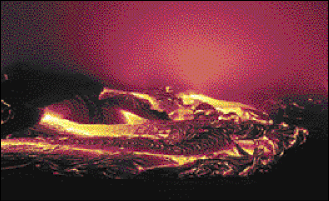Daniel C. McCarthy, Senior Editor/Special Projects
The Earth's surface represents less than 1 percent of the entire planet and most of the action in this corner of space occurs within the mantle and core, which remain largely inaccessible to on-site research. Consequently, study of the materials and processes occurring far beneath our feet requires diamond anvil cells, which simulate the extremely high pressures and temperatures there.
An example is geophysical research at the University of California, where a group of scientists use a diamond anvil cell to create silicate magmas. A photomultiplier from Quantar Technology Inc. is proving instrumental in helping these geophysicists collect Raman signals from the magmas to learn more about the attributes and behavior of Earth's component materials.

Raman spectroscopy aided with a microchannel plate photomultiplier tube is helping geophysicists characterize the processes that occur deep within
Earth's core and mantle.
One goal of the research is to force structural changes in the silicates to understand how their density changes as a function of pressure and ultimately to learn whether or not magmas rise or sink at different depths in the Earth. The study could also reveal bonding properties and behaviors of these materials.
The diamond anvil cell compresses samples between two flattopped diamonds glued in a piston-and-cylinder configuration. The top of each diamond measures a couple of hundred microns across and can simulate pressures of a couple of million atmospheres. A Raman spectrometer focused into a 10-µm spot collects the vibrational characteristics of the crushed silicate fluids.
Initially, the researchers tried a conventional thermoelectrically cooled CCD to collect the Raman signal but later switched to Quantar's two-dimensional position-sensitive microchannel plate detector. Quentin Williams, a professor of earth science at the university, explained that the experiments produce a very weak Raman signal with an abundance of stray light. He attributed the choice of Quantar's photomultiplier to its long 25-mm collection window, high sensitivity and low detector noise. "No signal bleeding [such as what occurs] between pixels in CCDs also helped a heck of a lot," he said.
The nonpixelated nature of the Quantar detector was invaluable, said Williams, who added, "We could always use better spatial resolution across the detector surface, but that's hard to do."
Quantar's detector delivers spatial resolution better than 50 µm (full width half maximum) with 1024 x 1024 X-Y digitized channels. Its active area measures 25 mm in diameter and can handle up to 100,000 photon counts per second during simultaneous detection. Time-integrated detection is limited only by the size of the external digital memory in which photon counts are stored.